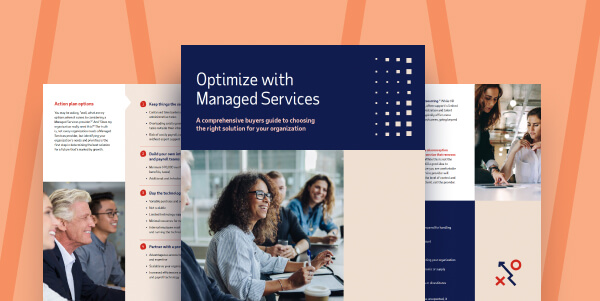Employee management that uses coaching to motivate and build trust with workers can unlock enormous human potential. Yet, communication tactics alone may fall short in the face of multi-generational workforces, rising numbers of freelance workers and complex regulations. Technology, whether it’s workforce management software or a human capital management solution, can often help business leaders maintain productivity more effectively in rapidly changing environments.
Table of Contents
What is employee management?
Employee management is the process by which employers ensure workers perform their jobs to the best of their abilities so as to achieve business goals. It typically entails building and maintaining healthy relationships with employees, as well as monitoring their daily labor and measuring progress. In this way, employers can identify opportunities for improvement and recognize achievements.

What responsibilities does employee management include?
Helping employees reach their full potential requires managers and supervisors to fulfill several of the following key responsibilities:
- Acquire talent
Filling open positions with the right people can make employee management easier from the start. That’s why many hiring managers are diligent about writing detailed job descriptions, sourcing and interviewing qualified applicants, and running background checks.
- Manage performance
Employees tend to do their jobs better and are more engaged when they are given opportunities to learn new skills or grow with the organization. To this end, employers may provide training and upskilling programs, encourage attendance at conferences and trade shows, or permit employees to adjust their roles according to their strengths and interests.
- Support two-way communication
Managers who want to make their employees feel included generally have open door policies and share important information about the business with them. They also provide a forum for individuals to express their ideas, opinions and complaints. This feedback is then used to address any issues that may be negatively affecting the workforce, improve processes and keep employees engaged.
- Recognize achievements
Employees who know their hard work is appreciated by management and senior leadership are typically more motivated to excel in their roles. Recognition can be a simple thank you or shout-out during a meeting, or a reward, such as a pay raise or promotion.
Why does employee management matter?
Employee management matters because lackluster workforce performance typically increases operating expenses. Not only that, but having to hire replacements or additional team members is time consuming and costly in its own right. By identifying problems and creating action plans for improvement, employers may be able to get the most out of their existing workforce and avoid unnecessary terminations.
What is an employee management system?
An employee management system is technology designed to streamline core HR services and improve workforce productivity. It accomplishes these goals largely by automating labor-intensive, administrative tasks and using analytics to drive business decisions. Depending on the vendor, the HR product suite may include talent acquisition, payroll, timekeeping, benefits administration and more.
Why is an employee management system important?
Employee management systems are important because a business’s workforce is its greatest asset. Yet, despite this intrinsic value, employee engagement is sometimes overlooked because HR professionals are either too busy with administrative work or lack the integrations necessary to use their people data effectively. Technology can alleviate such burdens and afford employers more time to connect with workers and create strategic initiatives that will attract and retain talent.
Benefits of an employee management system
Employers rely on employee management systems to help them not only maintain day-to-day workflows, but also solve complex challenges and achieve long-term business objectives. Some more specific benefits include:
- Increased productivity
The automation and machine learning capabilities that are common with most employee management systems can help HR departments accomplish more with less effort.
- Richer employee experiences
Mobile self-service features, online training and upskilling programs and flexible pay options are just a few of the ways technology can enrich the employee experience.
- Actionable insights
With predictive analytics and benchmark data at their disposal, employers may be able to make more informed workforce decisions and improve their profitability.
- Secure information
To deter hackers and prevent security breaches, employee management systems typically use multi-factor authentication, data encryption and fraud detection.
- Compliance support
Some employee management system providers offer global and/or local regulatory monitoring services that can help decrease the risk of fines or penalties for inadvertent non-compliance.
What are employee management services?
When employers choose to outsource their responsibilities to a third party, it’s sometimes referred to as employee management services. This arrangement is often beneficial for small and midsized businesses who have limited HR departments, lack compliance expertise or want to offer employee benefits comparable to those commonly available at larger organizations. Reducing the amount of time and resources spent on employee management also affords business owners the ability to focus more attention on growing their operations.
How do employee management services work?
A professional employer organization (PEO) provides employee management services on behalf of a client business. Examples include:
- Payroll and tax filing
- Benefits administration
- Compliance management
- HR support
- Workplace safety programs
- Talent management
Although these responsibilities are contractually shared between the two parties, the employer retains ultimate control of the business and its employees.
How do you choose the best employee management solution for your business?
Employers who exercise due diligence shop for employee management services as they would for any other strategic business need. Generally speaking, this means:
- Comparing solution capabilities based on how well they meet the individual needs of the business
- Looking at a provider’s financial, compliance and client retention records
- Talking to a provider’s existing clients, particularly those in the same industry
- Inquiring if a PEO is certified by the IRS or accredited by ESAC
- Asking for a cost analysis that shows how fees are allocated to the services provided
By following these steps, employers may be better poised to leverage technology and access comprehensive capabilities that will benefit both their business and employees.
Frequently asked questions about employee management
What is the purpose of an employee management system?
The purpose of an employee management system is to help improve workforce productivity, identify ways to engage and retain talent, and alleviate administrative burdens for HR professionals. Achieving greater efficiency through the use of technology can also help control costs and minimize compliance risks.
What is the best way to manage employees?
Employee management techniques tend to vary based on the particular industry and workplace culture. And while developing strong leadership skills can’t happen overnight, employers who foster talent effectively, often will:
- Clearly set expectations so that constant supervision is unnecessary
- Lead by example with consistency and integrity
- Involve employees in big picture business goals to help motivate them
- Create a total rewards program that recognizes top performers
How do you manage an employee remotely?
Managing employees remotely can be challenging due to a lack of direct supervision and face-to-face meetings, but those who do it well tend to:
- Have regularly scheduled check-ins with their direct reports
- Ensure employees have the technology necessary to support the desired means of communication (email, phone, video conference, etc.)
- Establish ground rules for communication frequency, deadlines, work hours and other performance-related expectations
- Make time for social interaction, whether it’s at the beginning of a call or during a virtual office gathering
What is worker management?
Worker management describes the process by which employers ensure optimal performance from their employees. This often requires a combination of traditional managerial techniques, like coaching and positive reinforcement, as well as state-of-the-art technology, which uses data to help monitor engagement trends, create workforce strategies and deploy them effectively.
This guide is intended to be used as a starting point in analyzing employee management and is not a comprehensive resource of requirements. It offers practical information concerning the subject matter and is provided with the understanding that ADP is not rendering legal or tax advice or other professional services.





